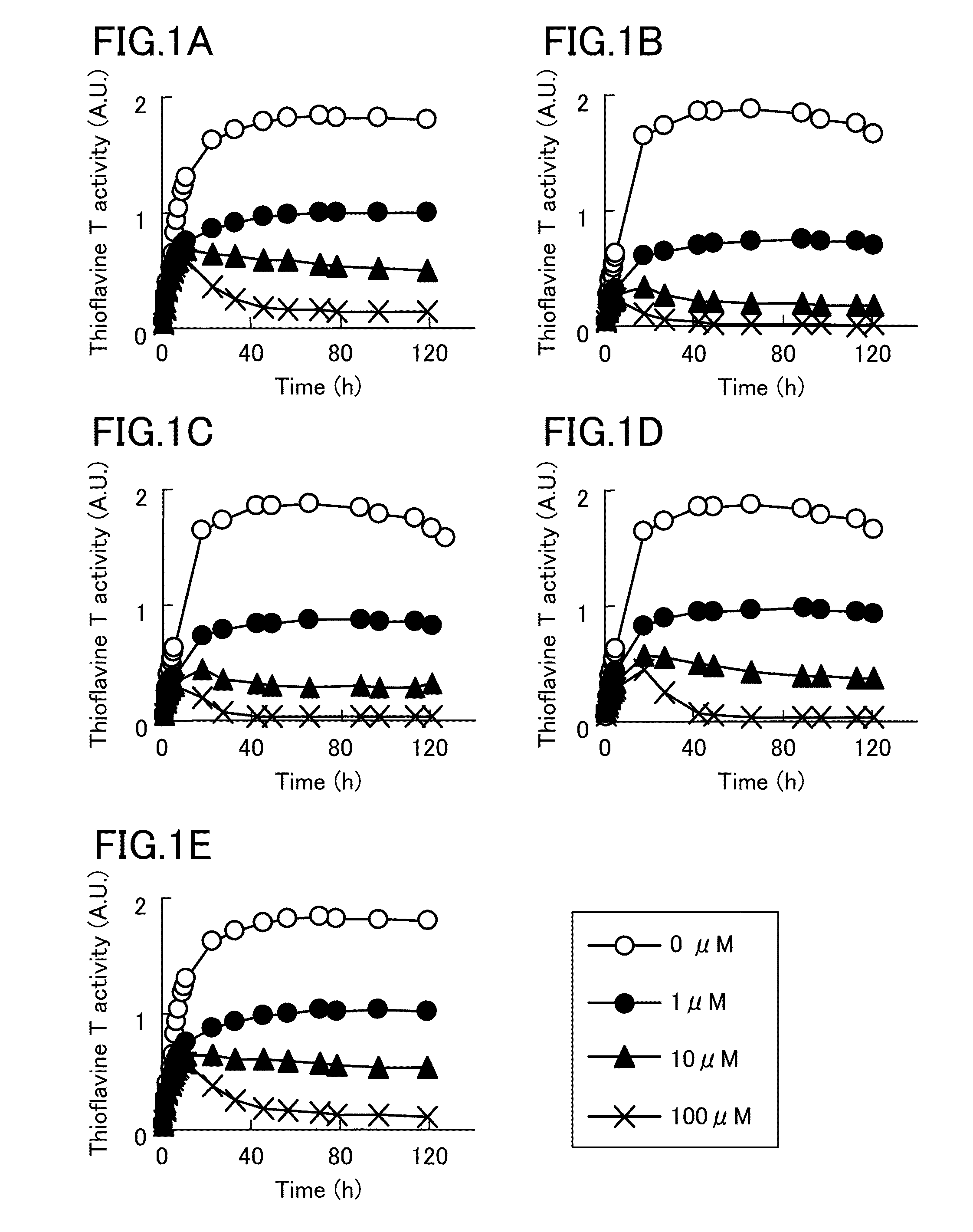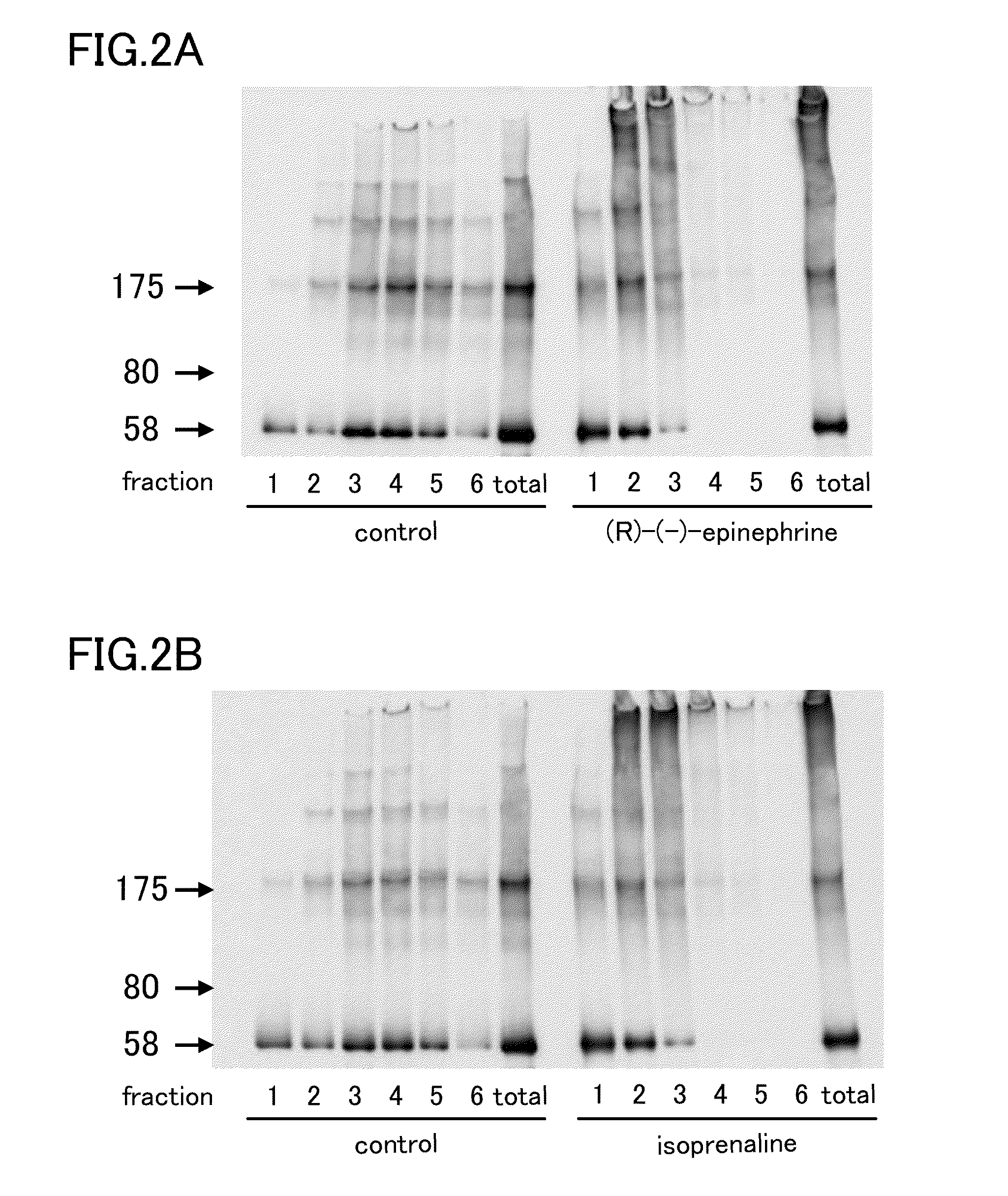Tau aggregation inhibitor
a technology of aggregation inhibitors and tau, which is applied in the direction of biocide, drug compositions, peptide/protein ingredients, etc., can solve the problems of ineffectiveness of acetylcholinesterase inhibitors for patients with advanced cases, neuronal abnormalities, neuronal death, etc., and achieves effective social contributions, sufficient reduction of tau aggregation in cells, and improved quality of life
- Summary
- Abstract
- Description
- Claims
- Application Information
AI Technical Summary
Benefits of technology
Problems solved by technology
Method used
Image
Examples
example 1
[0047]Compounds that can be bound to tau were screened. First, 10 μM of 2N4R tau (TAU-441 HUMAN) and 10 μM of heparin were mixed together and incubated at 37° C. to form tau aggregates. This aggregated tau sample (1 ml) was loaded onto a sucrose-density gradient solution (consisting of 1 ml layers 20%, 30%, 40%, and 50%), and was centrifuged (at 200000×g for 2 h at 20° C.). Then, the solution was collected in units of 1 ml from the top layer to obtain samples of fractions (Fr) 1-5. The resultant pellets were suspended in an HEPES solution to obtain a fraction Fr6. Thereafter, binding capacities between tau included in Fr 1, 3, and 5 with predetermined 6600 compounds were analyzed by a surface plasmon resonance technique. The surface plasmon resonance technique is a technique for analyzing an intermolecular interaction between two molecules by monitoring a change in refractive index caused by, for example, a change in molecular mass fixed on a thin gold film. The surface plasmon reso...
example 2
[0050]Then, it was analyzed, by thioflavine T stain, whether compounds whose structures resemble to (R)-(−)-epinephrine and pyrocatechol violet inhibit tau aggregation. As a result, as shown in FIG. 1, levodopa, dopamine, norepinephrine, and isoprenaline significantly reduced thioflavine T activity, similar to (R)-(−)-epinephrine. FIG. 1A shows a change in thioflavine T activity by (R)-(−)-epinephrine, FIG. 1B shows a change in thioflavine T activity by levodopa, FIG. 1C shows a change in thioflavine T activity by dopamine, FIG. 1D shows a change in thioflavine T activity by norepinephrine, and FIG. 1E shows a change in thioflavine T activity by isoprenaline.
[0051]Among these samples, the (R)-(−)-epinephrine sample and the isoprenaline samples were divided into fractions Fr1-Fr6 by sucrose-density gradient centrifugation, and tau was detected by SDS-PAGE western blotting. The concentration of the compounds used was 100 μM. As a result, as shown in FIG. 2, aggregated tau was detected...
example 3
[0052]Then, it was investigated whether isoprenaline inhibits tau aggregation in cultured cells. As cells, Neuro2a cell lines in which human P301L mutant tau (i.e., mutant tau in which 301st proline of tau is changed to leucine) is expressed in stable were used. To these cells, isoprenaline was added in concentrations of 0.01, 0.1, and 1 μM for 48 hours. Then, SDS-insoluble fractions were obtained so that a change in the amounts of tau was observed. As a result, as shown in FIG. 3, isoprenaline reduced the amounts of SDS-insoluble tau similarly to lithium chloride, a positive control, which is a glycogen synthase kinase 3β (GSK3β) inhibitor (e.g., a material that physically or chemically inhibits the function of GSK3β). FIG. 3A shows detection of tau in SDS-insoluble fractions, and FIG. 3B is a graph corresponding to FIG. 3A, and shows that isoprenaline reduces the amount of SDS-insoluble tau.
[0053]In addition, changes of tau phosphorylation in radio-immunoprecipitation assay (RIPA)...
PUM
| Property | Measurement | Unit |
|---|---|---|
| tau aggregation | aaaaa | aaaaa |
| aggregation | aaaaa | aaaaa |
| tonicity | aaaaa | aaaaa |
Abstract
Description
Claims
Application Information
 Login to View More
Login to View More - R&D
- Intellectual Property
- Life Sciences
- Materials
- Tech Scout
- Unparalleled Data Quality
- Higher Quality Content
- 60% Fewer Hallucinations
Browse by: Latest US Patents, China's latest patents, Technical Efficacy Thesaurus, Application Domain, Technology Topic, Popular Technical Reports.
© 2025 PatSnap. All rights reserved.Legal|Privacy policy|Modern Slavery Act Transparency Statement|Sitemap|About US| Contact US: help@patsnap.com



